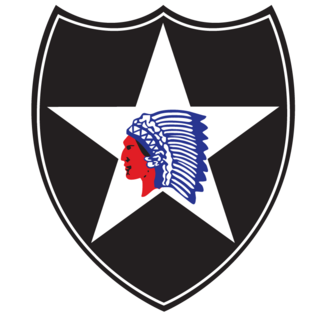
The Korean War was fought between North Korea and South Korea from 1950 to 1953. The war began on 25 June 1950 when North Korea invaded South Korea following years of hostilities between the two countries. North Korea was supported by China and the Soviet Union while South Korea was supported by the United States and allied countries. The fighting ended with an armistice on 27 July 1953.

The 2nd Infantry Division ("Indianhead") is a formation of the United States Army. Its current primary mission is the pre-emptive defense of South Korea in the event of an invasion from North Korea. There are approximately 17,000 soldiers in the 2nd Infantry Division, with 10,000 of them stationed in South Korea, accounting for about 35% of the United States Forces Korea personnel.

The 25th Infantry Division is a United States Army division based at Schofield Barracks in Hawaii. The division, which was activated on 1 October 1941 in Hawaii, conducts military operations primarily in the Asia-Pacific region. Its present deployment is composed of light infantry and aviation units. Tropic Lightning soldiers regularly train with other U.S. military branches to practice and maintain joint operations capabilities. The climate and terrain of the Pacific region demands Tropic Lightning soldiers be able to operate in physically demanding and harsh environments. In 2014, the division opened the Jungle Operations Training Center—the first such school in the Army since the closing of the old Jungle Warfare School at Fort Sherman, Panama Canal Zone. Joint operations and training with partner states herald a new chapter in the history of Tropic Lightning—America's Pacific Division.

The 1st Infantry Division is a military formation of the Republic of Korea Army's I Corps. The division was established on 1947 under the command of Colonel Kim Suk-won.

The 3rd Infantry Division is a military formation of the Republic of Korea Army.
The 6th Infantry Division is a military formation of the Korean People's Army Ground Force.
The 15th Infantry Division was a military formation of the Korean People's Army during the 20th Century. The division fought in the 1950 Korean War; it took part in the North Korean advance from Seoul to Taejon, and fought in the Battle of Pusan Perimeter. The 15th Division fought along the eastern coast, above Pusan, eventually being annihilated.
The 1st Infantry Division is a military formation of the Korean People's Army.
The 12th Infantry Division was a division of the Korean People's Army during the 20th century. Originally, it was the 156th Division, which was created in November 1948 under the Regulation of the Redesignations of All Organizations and Units of the Army, issued by Central Military Commission on November 1, 1948, basing on the 6th Independent Division, PLA Northeastern Field Army.
The 9th Infantry Division was a military formation of the Korean People's Army during the 20th Century.
The 115th Division was a military formation of the People's Volunteer Army during the Korean War with a standard strength of approximately 10,000 men. It was a component of the 39th Army, consisting of the 343rd, 344th, and 345th Regiments.
The 40th Group Army was a military formation of the People's Liberation Army, active in various forms from 1949 to 2017. It was last located in the Shenyang Military Region and the Northern Theater Command.
The 89th Division(Chinese: 第89师)(2nd formation) was a military formation of the People's Liberation Army.
The V Corps of the Korean People's Army was created before January 1951.
The 119th Division was a military formation of the People's Volunteer Army during the Korean War with a standard strength of approximately 10,000 men. It was a component of the 40th Army, consisting of the 355th, 356th, and 357th Regiments.
The 124th Division was a division of the PRC People's Liberation Army. During the Korean War, it was the first unit of the People's Republic of China to cross the Yalu River.
The 126th Division was a division deployed by the People's Republic of China.
The 77th Division was a military formation of the People's Volunteer Army during the Korean War.
The 88th Division was a military formation of the People's Volunteer Army during the Korean War. They were a component of the 30th Army. The 88th Division was assigned as a reinforcing Division to the 26th Army.
The 8th Field Artillery Regiment is a field artillery regiment of the United States Army first formed in 1916. The regiment served in World War I, World War II, and Korea, and regimental units have served in Vietnam, Honduras, Panama, Operation Desert Storm, Operation Enduring Freedom and Operation Iraqi Freedom. Currently organized as a parent regiment under the U.S. Army Regimental System, the regiment's only active component is the 2nd Battalion, 8th Field Artillery Regiment, currently assigned to the 1st Infantry Brigade Combat Team, 11th Airborne Division and stationed at Fort Wainwright, Alaska.




